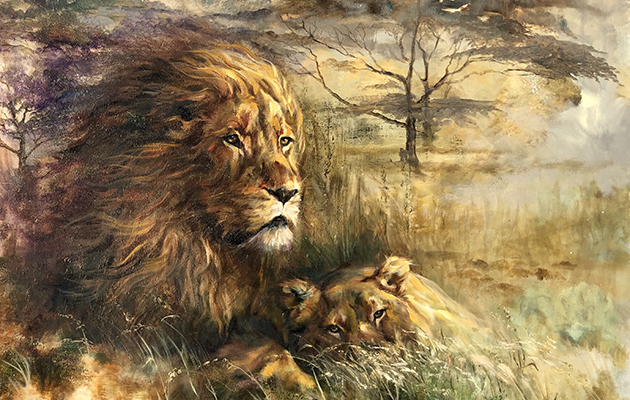Michelle Pearson Cooper tells Janet Menzies why she puts two of Earth’s fastest land mammals on a pedestal
Fascinated by the cheetah, Michelle Pearson Cooper was struck by their similiarities to her beloved lurchers. She tells Janet Menzies how she is bringing the same respect we all have for endangered big cats to domestic dog portraiture.
For more sporting artists, size might not matter for Knox Field, but gravitas certainly does. And Justin Prigmore uses close and careful study to capture his subjects with such precision.
MICHELLE PEARSON COOPER
Nomadic peoples have a much closer relationship with nature than those who have settled down and put up walls between themselves and the wilderness outside. Among the Bedouin it is traditional to keep a prized horse within the camp, and even in the tent, in much the same way as we have our favourite dogs sitting beside the fireplace. The habit of keeping wild animals at close quarters persists in the Arab world. Wildlife artist Michelle Pearson Cooper had a rather-too-close-for-comfort experience of this when she was commissioned to paint the portrait of Bahraini-Emirati businessman Mohammed Mahdi Al Tajir. “He had two cheetah, Marzuq and Kamal, that lived with him – they weren’t tame at all. I spent time observing him with his cheetah and they did put you to the test. They can’t retract their claws and your ankles certainly suffered. But I couldn’t let them sense that I was scared.”

Dazzle.
This was a formative experience for Pearson Cooper, who became absorbed with the Arab world and with cheetah. “I found them fascinating and I was able to see them in Namibia. They are magnificent.” Her ninth exhibition, ‘Timbuktu and Beyond’, featured the cheetah of the Namibian desert, as well as images of the nomads of the Sahara, in particular the Tuareg tribe. She stresses: “Cheetah are on the decline, especially in Namibia, hunted by predators, poachers and those who seek to protect their livestock.”
Pearson Cooper is able to study cheetah at close quarters at the Tenikwa Wildlife Awareness Centre’s rehabilitation and conservation project in South Africa’s Plettenberg Bay. She explains: “We spend three months of the year in South Africa and love it. Tenikwa is not far away and I spend a lot of time there. The reserve rescues cheetah cubs when their mothers have been victims of poaching. As far as possible they try to release them back into the wild. It can’t always be done if there has been a lot of human contact, but there is still the opportunity for research and education, especially for the local people.”

Michelle Pearson Cooper at work in her studio.
Back in England, Pearson Cooper is struck by the similarities between cheetah and her beloved lurchers. This isn’t surprising since cheetah are acknowledged to be the fastest land mammal, with maximum speeds of around 70mph, and greyhound/lurchers are also in the top 10, with a top speed of around 45mph. Pearson Cooper explains: “These are the Formula One of the animal world. Cheetah have to be pretty strategic before they start their sprint because they know they have a limited amount of time to run to catch their prey, so they have to go for the weakest.” It is unfortunate for springbok and related antelopes that they are only the third fastest land mammals, achieving speeds of 55mph, usually when pursued by one of the big cat species. It is a similar scenario with greyhounds and hare, greyhounds having a speed advantage of just a couple of miles an hour over their quarry – but only in short bursts. Pearson Cooper observes: “I hate it when our dog manages to catch a hare, but it is what they do.”
REIGNING CATS AND DOGS
Is this what prompted the juxtaposition of big cat paintings and domestic dogs in her exhibition this autumn, titled ‘Reigning Cats and Dogs’? “Well, it is a pun, of course, but it is really because I think we all put our dogs on a pedestal and we probably overindulge them. They are a very big part of our lives. Our dogs make a home for us. They work on us more than we work on them. That was my main feeling behind the title. But then, I am also doing a lot of wild cats.”
For Pearson Cooper, this is instinctive. She paints dogs with the same respect and fascination that we all have for the endangered big cats. She explains: “In my dog portraits I want to have respect and intuition, and to never underestimate the dog’s intelligence. Dog portraiture is sometimes a bit chocolate boxy and I try to achieve something painterly. I try very hard not to get too photographic. I have made the mistake in the past of getting too tight in my painting and I don’t want to lose the movement, I don’t want to be too rigid. The composition is important as well. It must be a work of art as well as a portrait.”

Weimaraner Dozing.
In the past this would have been condemned by art critics, who didn’t consider dogs to be a fit subject for art. But Pearson Cooper is unapologetic: “I am not intellectual about it, and I can’t explain it. Sometimes there is a telepathy in painting and it is instinctive. The imagery is embedded in your mind somewhere.”
So she has brought the dogs inside the tent along with the cheetah.
‘Reigning Cats and Dogs’ is at The Osborne Studio Gallery, 2 Motcomb Street, London SW1X 8JU until 21 November 2020; call 020 7235 9667.
View Michelle Pearson Cooper’s work at: michellepearsoncooper.co.uk





